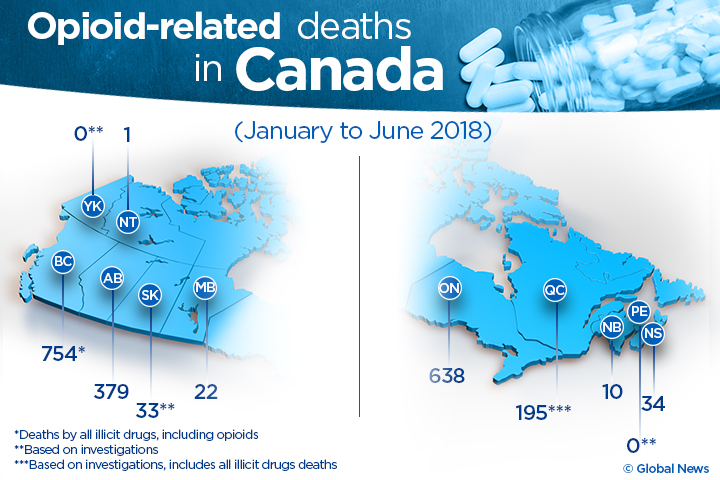More than 2,000 Canadians died at the hands of the opioid crisis in the first half of 2018, according to new numbers released by the Public Health Agency of Canada.

That means the total number of opioid-related deaths in the country since January 2016 is now at least 9,000. Numbers for the second half of 2018 have not been released.
READ MORE: Nearly 4,000 opioid deaths in 1 year, Canada hasn’t called a ‘public health emergency.’ Here’s why
“These statistics suggest that we have not yet turned the tide on the crisis,” a release from the health agency read.
An overwhelming majority of the reported deaths in 2018, at 94 per cent, were caused by accidental overdoses, 72 per cent of which were related to fentanyl.
WATCH: How profitable is fentanyl

The government report noted that the continuing crisis contributed to the slowing of Canada’s life expectancy — which was steadily rising from 2000 to 2016.
As previously reported in British Columbia, where the crisis has been most pronounced, the life expectancy has fallen.

Get weekly health news
B.C. recorded the most deaths in the first six months of 2018 at 754; that number encompasses all illicit drugs, including opioids.
The second-highest death toll was in Ontario, where 638 people died.
Here’s a breakdown of opioid-related deaths across the country:
There were more deaths in the first half of 2018 than in the same time last year, when there were 1,895.
Opioid hospitalizations
Canada has also experienced a rise in opioid overdoses and harms that weren’t fatal.
The latest numbers crunched by the Canadian Institute for Health Information show that an average of 17 people across the country were hospitalized each day due to opioid poisonings in 2017. That’s a slight increase from 2016, which saw 16 daily hospitalizations on average.
READ MORE: No federal supports, funding planned for children caught up in opioid crisis
Between 2016 and 2017, emergency department visits for such poisonings increased the most in Alberta (23 per cent increase) and Ontario (73 per cent increase).
A majority of those visiting the ER, at 71 per cent, were men. Young and middle-aged Canadians were most likely to be involved in opioid-related overdoses.
Politicians promise action
Federal politicians spent Monday night in the House of Commons debating the best ways to tackle the opioid crisis.
At the emergency debate, Health Minister Ginette Petitpas Taylor talked about how the Liberal government supports harm reduction “because we know that harm reduction saves lives.”
WATCH: Health minister says declaring a public health emergency wouldn’t help opioid crisis

Under the Liberals, the federal government has approved over 25 supervised consumption sites, facilities where people can ingest drugs with medical staff nearby.
Conservative MP Marilyn Gladu challenged the Liberals on their spending, noting that they decided to spend $4.5 billion on the Trans Mountain pipeline, but have set aside just over $200 million for the opioid crisis.
Budget 2018 set aside $231.4 million to tackle the crisis, with $150 million going to the provinces and territories so that they could improve access to evidence-based treatment services.
That also included $13.5 million to expand Health Canada’s Substance Use and Addictions Program, which doles out money to provinces, territories and other organizations to strengthen responses to substance use issues.
— With files from Global News reporter Jesse Ferreras









Comments